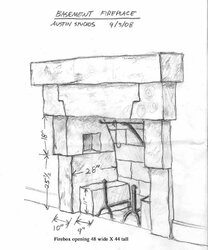Hi all,
I have a high end client that insists on some kind of natural stone in the firebox. He likes the old cooking fireplace designs from the 1800's. Attached is a drawing. I've got about 60hrs of research that has led me to sandstone from Ohio. Seems it has some good refractory qualities. (Used in blast furnaces in 19 century)
The client would like to use the stone that is on the outside of the house, (Sericite Schist...Mica and Feldspar I think), but there's not much info available about it.
Anyone have any experience here?
Thanks,
Kevin
I have a high end client that insists on some kind of natural stone in the firebox. He likes the old cooking fireplace designs from the 1800's. Attached is a drawing. I've got about 60hrs of research that has led me to sandstone from Ohio. Seems it has some good refractory qualities. (Used in blast furnaces in 19 century)
The client would like to use the stone that is on the outside of the house, (Sericite Schist...Mica and Feldspar I think), but there's not much info available about it.
Anyone have any experience here?
Thanks,
Kevin


